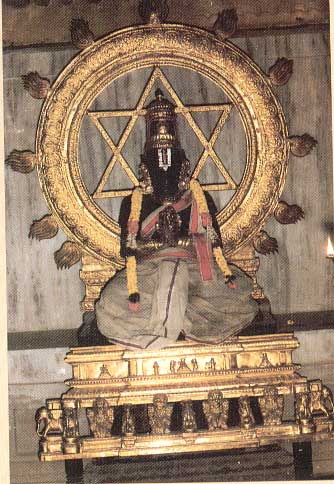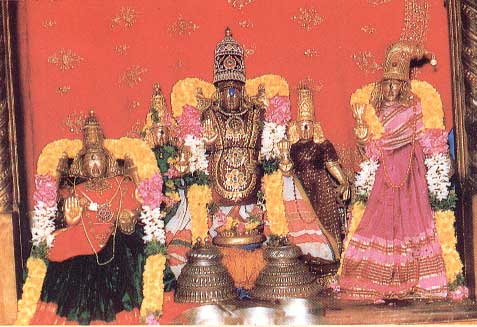Today's [21st January 2009] lecture is from Anjaneya
sannidhi in Sriperumbudur. We worshiped Sri Rama, Sri Sita and Lakshmana in
Swami Ramanuja's
sannidhi earlier. Exactly opposite to that
sannidhi is Anjaneya's
sannidhi. On
Masi [மாசி]
Amavasya [New moon day], an elaborate festival is celebrated for Anjaneya. That day Sri Adi Kesava
Perumal arrives here and then graces in procession with Anjaneya. Just like Anjaneya devoted himself totally to Sri Rama,
Swami Ramanuja devoted himself to Sri Ranganatha. Thus to
Swami Ramanuja and Anjaneya, Sri Ranganatha, worshiped by Sri Rama, was the God.
Swami Ramanuja had many names and by chanting them our sins are eliminated. Ilaiyazhvar [இளையாழ்வார்] was the name christened to him by his parents. After he adopted priesthood [
sanyasasrama], Lord Sri Varadaraja and
Swami Periya Nambi, christened him as Ramanuja, in Kanchi. His other names were Udaiyavar, Emperumanar, Sri Bhashyakara and Godagraja, etc. Udaiyavar name was given by Lord Sri Ranganatha, and it signifies possessing
Ubhaya [both]
Vibhutis -
Leela vibhuti [this Universe] and
Nitya vibhuti [
Vaikuntam].
Swami Thirukoshtiyur Nambi was one of the
Acharyas of
Swami Ramanuja. He decorated him with the name Emperumanar [எம்பெருமானார்].
Swami Ramanuja had travelled Eighteen times from Srirangam to Thirukoshtiyur, to learn the significance of
Thirumantram [Ashtaksharam] and
Charama sloka [of
Gita]. Now, we can reach Thirukoshtiyur from Srirangam in One and Half hours by a vehicle. But in those days they had to walk the distance. Every time
Swami Ramanuja went to
Swami Thirukoshtiyur Nambi, he was sent back saying that he had not matured [to learn and grasp the meaning]. On the 18th visit,
Swami Ramanuja was taught the significance of
Thirumantram and
Charama sloka. Further,
Swami Thirukoshtiyur Nambi ordered Swami Ramanuja that he should not preach what he learnt to others unless he was satisfied that the person learning was tested, as done by
Swami Thirukoshtiyur Nambi on
Swami Ramanuja!
Swami Ramanuja agreed, but did not act accordingly. In Thirukoshtiyur temple is
Ashtanga vimanam, which we saw Two years back. Sitting on the
vimanam and setting aside his promise to
Swami Thirukoshtiyur Nambi, he preached
Thirumantram and
Charama sloka! On hearing this,
Swami Thirukoshtiyur Nambi, living in the same street, came to
Swami Ramanuja and asked as to why he violated his promise.
Swami Ramanuja pleaded guilty and agreed that he would reach hell only for the violation. But,
Swami Ramanuja said that by doing as he did, only he would go to hell, while all those listening would reach
Vaikuntam! Thus his broadmindedness and humane nature were seen by Swami Thirukoshtiyur Nambi and was very much pleased and praised him. He then gave him the title Emperumanar. Swami Ramanuja made a detailed commentary,
Sri Bhashyam, on Veda Vyasa's
Brahma sootram. This got him the title Sri Bhashyakara [ஸ்ரீ பாஷ்யகாரர்]. Sri Andal regarded
Swami Ramanuja as Her elder brother. In this place also in the month of
Aadi, Sri Andal festival is celebrated when along with
Swami Ramanuja, She comes in procession.

Sri Andal in Her
Nacchiyar Thirumozhi, had sung offering to the Lord of Thirumaliruncholai [Azhagar koil near Madurai] Hundred
thada [large vessel] of
akkara adisil [preparation of rice, milk and
jaggery] and Hundred
thada of butter! This verse was sung many centuries before
Swami Ramanuja was born. While studying this
pasuram of Sri Andal,
Swami Ramanuja wanted to fulfill Her desire. So he went with his entourage to Thirumaliruncholai, and got prepared the
akkara adisil and butter in the quantity mentioned by Sri Andal and offered them to the Lord! He then came to Srivilliputhur and reported to Sri Andal that he had fulfilled Her ambition! She was delighted and addressed him as '
Anna [elder brother]'! Thus he became Her
agraja or elder brother. So
Swami Ramanuja had many titles. We will now see
sloka 11 of Chapter 13. This is the last of the Five
slokas, wherein the Lord lists Twenty qualities necessary for
atma gyana. Now
sloka 11:
adhyatma-jnana-nityatvam
tattva-jnanartha-darshanam
etaj jnanam iti proktam
ajnanam yad ato ’nyatha
"accepting the importance of self-realization; and philosophical search for the Absolute Truth—all these I declare to be knowledge, and besides this whatever there may be is ignorance."
The Lord tells the last two qualities to Arjuna. By bringing into practice these Twenty qualities, will enable to acquire
atma gyana. All others will not help to acquire
atma gyana. 19.
Adhyatma-jnana-nityatvam = always in thoughts about atman. 20.
Tattva-jnanartha-darshanam = trying to understand the knowledge about truth. We should always strive to understand truth.
Etaj jnanam = this knowledge,
iti proktam = what was told,
anyatha = others are,
ajnanam = ignorance. We will recapitulate the Twenty qualities:
- Respect elders.
- Never donate for publicity.
- Never hurt.
- Be patient.
- Be honest.
- Serve Acharyas.
- Be clean [in action, words and thoughts].
- Be steadfast.
- Control mind.
- Avoid sense pleasures.
- Understand atman and body are not same.
- Remember life is sorrowful with births, deaths, oldage, diseases and misries.
- Be indifferent to all, except atman.
- Avoid excessive attachment to kith and kin.
- Have balanced mind in desirables and undesirables.
- Devote only to the Lord Sri Krishna.
- Prefer solitude.
- Dislike crowds.
- Always ponder over atman. And,
- Pursue truth.
All these alone would help in
atma gyana; other than these, are not useful for
atma gyana. In the beginning of the Chapter the Lord started to explain the nature of body and soul. We had seen the nature of the body: assembly of organs, composed of the Five elements, a residence for atman to enjoy and suffer, etc. The Lord is going to tell about
atman. But before that one has to acquire
atman gyana, and these Twenty qulaities are necessary for that.
Swami Ramanuja, who was born here, practiced all these Twenty qualities in his life. Hanuman also exhibited thses qualities. Thus these are not mere theoretical lessons; but have been practiced in actual life. We will now take leave of this
Kshetram. We should remember that
Swami Ramanuja was
Jagadacharya, King aming ascetics [
yatiraja], humanitarian, author of Nine works, preacher of
bhakti on Sri Ranganatha, server in all temples, establisher of 74
Simhasanadipatis, teacher of
saranagati for all to attain
Moksham, propagator that all could attain
moksham, etc. In the next 8 or 9 years we are to celebrate his millennium birthday. Before that let us strive to bring into practice his noble qualities.










